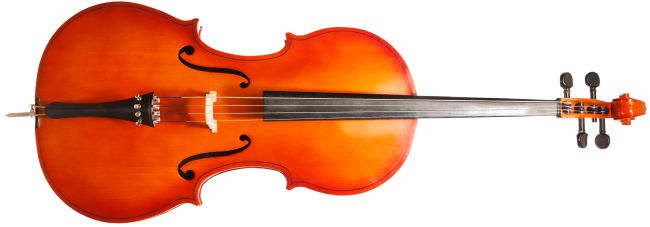Stradivarius Violins • Antonio Stradivari
Definition of a Cello

Boasting a deep and warm sound, a cello is a large bowed-string instrument in the violin family of instruments. It is the youngest member of the family and a late bloomer in terms of design and proportion.
Larger than a violin and smaller than a bass, a full-size cello stands 4 feet tall and 30 inches wide. Mostly crafted of wood, a cello may also have parts of steel, rubber and metal.
The main body of a cello features a wide top, narrow middle and broader bottom. The bridge and f-holes are located in the center. Most cellos are made from wood, with the back, sides and neck usually constructed with maple.
Above the main body are the neck, pegbox and scroll, usually carved out of a single piece of wood. The pegbox features four tapered tuning pegs which protrude laterally from a curving pegbox. In order to support thicker strings, the pegbox is wider than that of the violin, featuring unique boxy shoulders toward the bottom end. The scroll is at the top end. The slop of the pegbox is designed to stretch the strings across the nut.
Every cello also features a tailpiece and endpin, both of which serve to support the cello while it is being played. The retractable metal endpin is placed at a comfortable distance, while the side touches the floor for stability.
The bridge of the cello lifts the strings above the fingerboard, staying in place from the tension from the strings. The cello also features f-holes on both sides of the bridge. In addition to producing quality sound, f-holes can be used as access points to the inside of the body for repairs or maintenance.
The inside of a cello features a bass bar and a round wooden sound post. The bass bar supports the backbone of the instrument, while the sound post is designed for conducting and absorbing sound.
Cellos are played as part of the symphony orchestra, in quartets and ensembles, and in solo performances.
History: The cello was born in the fifteenth century out of a need for a lower toned instrument. However, it was a work in progress until the eighteenth century, depicted in a greater variety of designs than the violin. Although Stradivaris B form is considered impeccable, luthiers continue to play with the detail and fittings of the cello to this day.
The early cello was tuned in different ways and made in a broad variety of sizes. Some of the first cellos featured shorter necks and a short, wedge-shaped fingerboard. Notable cello makers include Nicolo Amati, William Forster, Francesco Ruggieri, Giuseppe Guarneri, Antonio Stradivari and Alessandro Gagliano.
